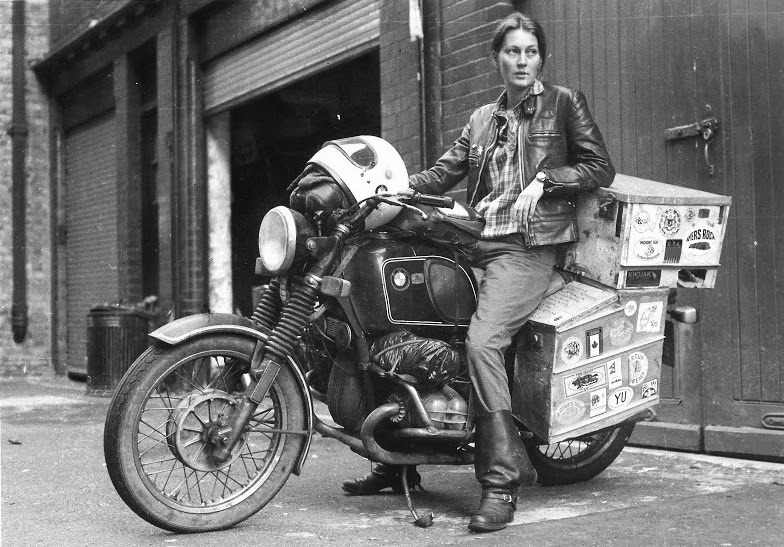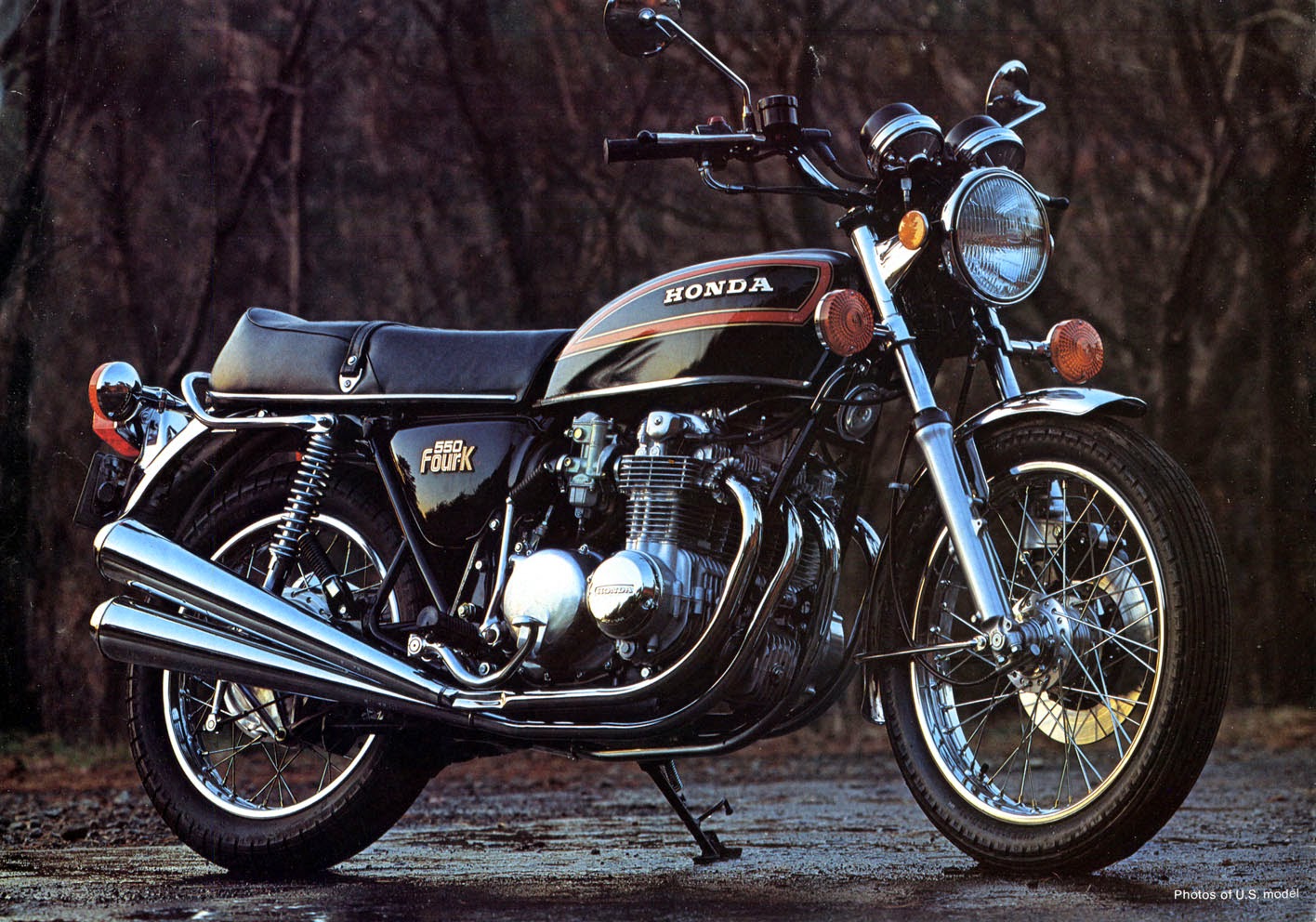"What other bikes did you ride," I ask my father-in-law. "Before the 550?"
I am again trying to find a gentle way of getting him to do something with the old Honda CB550 that sits in the back of a garage in Devon. Give it to me. Drag it out and restore it. Something. Don't just let it sit there.
Jenn can remember riding on the back of it as a girl. For quite a long time, motorcycles were her father's only means of transport; well into Jenn's early teens, he didn't even have a car driving license (a). He only gave in after having to Jenn's mother to the emergency room one evening after she cut her hand. She had to ride on the back of the bike, through undulating Devon country lanes, holding on with just one hand –– the other elevated in the air and spurting blood. After this incident, Paul was informed in no uncertain terms that he would finally be getting his car license or suffer in all sorts of terrible ways.
Not too long afterward, he attempted to ride his Honda through a flood and the engine died on him. He got it back to his house, put it in the garage, and it's been there ever since.
"My first bike was a James 125," Paul says. "Well, actually, I took my test on my father's Lambretta. Back then, once you'd taken your test you were free to set out on anything."
The Lambretta. Oh.
I suspect an entire novel could be written about the Lambretta. But the men of my wife's family are true Englishmen, which is to say they are not natural storytellers. The Welsh and Texans, we can talk for hours about anything. We can draw narrative from a trip to the cornershop to get milk. But my wife's brother, father and grandfather are the sort who don't care to share details; they are too comfortable with silence. So, I don't know a great deal about the Lambretta, but for the fact Jenn's grandfather bought it shortly after returning from the Suez, where he had been stationed in the early 50s.
Fuel rationing inspired him to walk most places and use the scooter for longer trips; they may have had a car, but they preferred not to use it. Jenn's grandfather had to me made passing mention of this scooter when
I rode down to visit this past autumn. He had made it sound as if he'd not owned the Lambretta for long, but obviously he held onto it at least until 1971, when my father-in-law would have been 16 years old and eligible to take his test.
![]() |
| James 125 |
Seeing me squint in confusion at the mention of a James 125, Paul explains that his first bike was "an ancient thing."
I had never heard of a James motorcycle. Later research reveals that
James Cycle Co. folded when Jenn's dad was just 11 years old. And although his parents had enough money to send him to boarding school, I doubt very much that his mother, Jenn's forthright grandmother, would have put forward so much as a thruppence toward her son's first motorcycle. He would have had to pay for it out of his own pocket, which suggests the bike would have been very old indeed.
"After that, I had a Norton. A Commando," my father-in-law says. "Then a Triumph Bonneville. That was my favourite, I suspect."
I almost sprain my neck doing a double-take as she looks at me, smiling. This moment will spin in my mind for the next several days. Chris is going to get a Triumph, she said –– is. And the fact she remembered the name of the bike!
I mean, my wife does a good job of seemingly not caring about my obsession for motorcycles. She's supportive enough, and nods kindly when I wander again into a tangent about the merits of shaft-driven bikes, or my guesses as to why Italy has so many more manufacturers than anywhere else, or some equally boring topic, but I can tell it's not her thing. Honestly, I wouldn't be surprised if she couldn't name the model of bike I ride at the moment.
I had showed her just one picture of the Thruxton after I came back from
Motorcycle Live and commented that I liked it. But I've made the same sort of comment about
literally dozens of motorcycles. That she remembers this particular one is telling. In her comment to her father Jenn had accidentally shown her hand. I'm happy she did. Her opinion plays a big part in all my decision making.
![]() |
| Triumph Thruxton |
"A Thruxton?" her father asks.
"It's like a Bonneville, isn't it Chris?" Jenn says. "Kind of like one of those... you know... mods and rockers bikes. Wait, when was that? When were the mods and rockers?"
"The riots in Brighton were in '64," I say. "So, before your dad's time."
"Yes. I'm not sure about mods and rockers... I don't know what we were," Paul says. "But we did have quite a few... erm... disagreements with the chaps on scooters."
"You were a rocker, Daddy," Jenn says. "I'll bet you were totally a rocker."
Of course he was, I think. This is the man who snuck out of boarding school at age 15 to go see Jimi Hendrix play the
Isle of Wight Festival. Having told the school he was heading home to see a doctor, he was found out when his mother called the school and asked to speak to him.
"That Triumph was so loud," my father-in-law says with a nostalgic smile. "I kept it in a garage that I was renting from some people. It was so loud they eventually paid me to take it elsewhere. I really enjoyed that one. It made such a racket."
"It's a shame you didn't keep it," Jenn says.
"Couldn't afford to," he says. "Everything always needed replacing. I spent so much money getting new parts. After that I had a Suzuki something-or-other for a while. That was the low point of my motorcycling career."
"How so?" I ask. "Did it fall apart on you?"
"No, it's just... there was nothing to it, you know?" he says with disgust. "It just went, but it had no life. No joy. No point. I couldn't stand it."
Quietly, in my head, I abandon the
GSX1250FA as a potential future steed. It's never appealed to me too much, anyway. But its getting that sour look from my father-in-law almost certainly writes of Suzuki in my wife's mind. And unless you're crazy for it, why even consider a bike that won't make you look sexy in your wife's eyes?
"Well, that was the era of the UJM," I say. "Was your Honda any better?"
"It was," Paul says. "It was a good machine. Never gave up on me, 'til I rode it into a river. I'd like to do it up. It's in the back of that garage. I won't give it up. That's one of the things I'd really like to do: like to fix it up and get back on it before I get on too much in years."
"Chris would be happy to help," Jenn volunteers.
"I would," I say. "I'd love to. It's a pretty popular bike with restorers, so I'm certain it wouldn't be too hard to get parts."
"Yes, I'd like that," my father-in-law says. "Maybe. Not right at the moment –– I've got a lot on these days, you know –– but, yes, maybe..."
![]() |
| Honda CB550 |
––––––––––––––––––
(a)The two licences are separate in the United Kingdom, as opposed to the way a car driver's license is requisite to motorcycle endorsement in most U.S. states.


















































